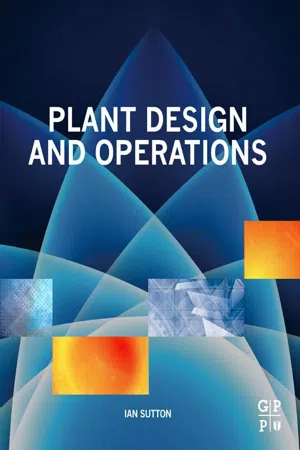
- 408 pages
- English
- ePUB (mobile friendly)
- Available on iOS & Android
Plant Design and Operations
About this book
Plant Design and Operations provides practical guidance on the design, operation, and maintenance of process facilities. The book is based on years of hands-on experience gathered during the design and operation of a wide range of facilities in many different types of industry including chemicals, refining, offshore oil and gas, and pipelines. The book helps managers, engineers, operators, and maintenance specialists with advice and guidance that can be used right away in working situations.Each chapter provides information and guidance that can be used immediately. For example, the chapter on Energy Control Procedures describes seven levels of positive isolation — ranging from a closed block valve all the way to double block and bleed with line break. The Safety in Design chapter describes topics such as area classification, fire protection, stairways and platforms, fixed ladders, emergency showers, lighting, and alarms.Other areas covered in detail by the book include security, equipment, and transportation. A logical, practical guide to maintenance task organization is provided, from conducting a Job Hazards Analysis to the issue of a work permit, and to the shutdown and isolation of equipment. Common hazards are covered in detail, including flow problems, high pressure, corrosion, power failure, and many more.- Provides information to managers, engineers, operators and maintenance personnel which is immediately applicable to their operations- Supported by useful, real-world examples and experience from a wide range of facilities and industries- Includes guidance on occupational health and safety, industrial hygiene and personal protective equipment
Frequently asked questions
- Essential is ideal for learners and professionals who enjoy exploring a wide range of subjects. Access the Essential Library with 800,000+ trusted titles and best-sellers across business, personal growth, and the humanities. Includes unlimited reading time and Standard Read Aloud voice.
- Complete: Perfect for advanced learners and researchers needing full, unrestricted access. Unlock 1.4M+ books across hundreds of subjects, including academic and specialized titles. The Complete Plan also includes advanced features like Premium Read Aloud and Research Assistant.
Please note we cannot support devices running on iOS 13 and Android 7 or earlier. Learn more about using the app.
Information
Operations
Keywords
Introduction
Professional Advice
Regulations, Standards, and Guidance
Regulations
Industry Standards
Table of contents
- Cover image
- Title page
- Table of Contents
- Copyright
- Chapter 1. Operations
- Chapter 2. Maintenance and inspection
- Chapter 3. Energy control procedures
- Chapter 4. Occupational safety
- Chapter 5. Chemicals
- Chapter 6. Personal protective equipment
- Chapter 7. Health and industrial hygiene
- Chapter 8. Human factors and ergonomics
- Chapter 9. Firefighting
- Chapter 10. Safety in design
- Chapter 11. Siting and layout
- Chapter 12. Equipment
- Chapter 13. Piping and valves
- Chapter 14. Safety instrumentation
- Chapter 15. Transportation
- Chapter 16. Security
- Chapter 17. Common hazards
- References
- Index